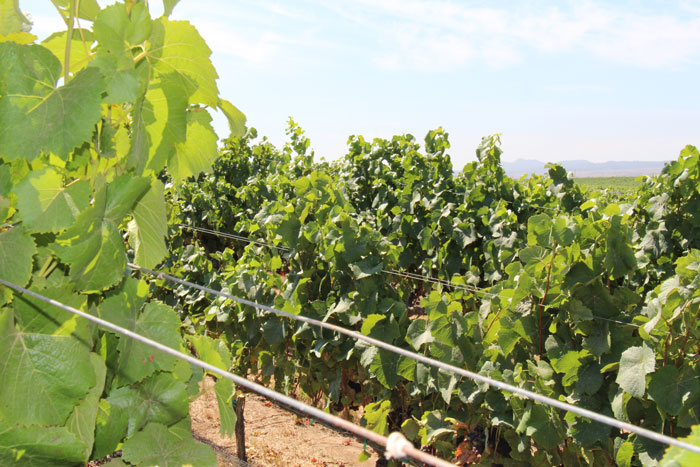
Accurately sampling changes in sugar and acid levels as your grape crop matures is a critical step in planning your harvest operation. But, it’s complicated by a number of factors affecting berry development – from topography and soil types to age of the vines and weather, disease and pest stress – which can change from one vineyard block to another.
Lindsay Jordan, University of California Cooperative Extension viticulture advisor for Madera, Merced and Mariposa Counties offers these tips for collecting and processing samples of the fruit that best represent your overall crop.
Where and when to sample
Independently collect samples from any sub-blocks that will be harvested separately, for reasons such as maturity differences, logistics or difference in rootstocks.
Don’t take samples from vines at the end of a row or the rows at the edge of the vineyard. Because grapes here can ripen faster than the others in the vineyard block, they won’t properly represent the entire block.
Sample for sugar in the cool morning, since sugar levels of grapes collected in the heat of the day will register artificially high. Avoid sampling during rain, dense fog or dew, which can produce diluted values.
Processing your sample.
Accuracy hinges on insuring every berry in the sample is crushed. Leaving under-ripe fruit uncrushed will result in juice that appears riper than what is actually in the vineyard.
After crushing the berry sample in a clear plastic bag, visually check for any intact berries and crush them, as well. Berries can also be crushed in a food mill or with a type of kitchenware commonly used in canning to separate fruit skin and pulp from juice.
“After the fruit is crushed, you can clarify it using a coffee filter, paper towel, or centrifuge to remove solids,” Jordan says.” No matter how you process your grapes always process samples the same way if you want to compare results for harvest scheduling.”
Account for variability in the vineyard
Collect grape samples that represent any variations in vine growth or stress within the vineyard block, due to different soils, clogged irrigation lines, replanted areas, weed infestations or other causes.
Aerial images, whether from an online search engine satellite map or commercial service using such technology as infrared and NDVI (normalized difference vegetative index). can also be helpful for identifying crop growth differences within a single block or across an entire vineyard property. Jordan notes.
Accurate sampling also requires getting a proportional sample from different areas of vine growth.
“For example, if your vineyard block has a natural swale in the middle where vines are growing much more vigorously and generating denser canopies, this fruit will likely mature more slowly than the rest of the vineyard,” Jordan notes. ”If this denser part of your vineyard represents 20 percent of the whole block, then 20 percent of your samples, either berries or clusters, should come from that area for your maturity sampling.”
Sampling method options
Whether you collect individual berries from clusters to create a pooled sample or whole clusters to sample grape maturity each offers advantages as well as disadvantages.
Berry Sampling
Typically, this requires at least 100 berries. However, for processing and accuracy Jordan recommends collecting 200 or more berries.
Collect berries from both sides of the vine row and from all parts of the cluster, equally sampling berries from the top, front, back and bottom of clusters located in positions across the entire fruiting zone of the vine.” Jordan says.
Pros:
A bag of berries is much easier to carry around, crush and process than a heavy bucket of clusters, she notes.
Processing berry samples and ensuring all berries are crushed and sampled for accurate juice readers is easier than with clusters.
Berries can be weighed to track berry growth at the start of the season and later, shrinkage from dehydration.
Berry sampling works well for varieties with looser clusters where individual berries are easy to collect.
Cons:
Sampler bias to collect only the ripe berries can lead to artificially high sugar readings.
Sampler bias can favor collecting berries at the top and bottom of the cluster and misrepresenting the central region of the cluster.
Samples taken early in the season, when fruit is not as ripe, may not yield enough juice for sugar and acid measurements.
Cluster Sampling
Properly sampling a vineyard requires a minimum of 20 to 30 clusters, while 40 or more is best for large and/or variable blocks, Jordan says. She advises collecting clusters from both sides of the vine row and from all positions on the vine – near the head, middle of the cordons/cane and edge of the cordon/cane.
Pros:
Assures berries are sampled from everywhere on the cluster and avoids bias from collecting fruit on only the top and bottom of clusters.
Samples can be weighed to track cluster weight for yield estimations.
Cluster sampling works well for varieties with compact clusters where individual berries are hard to collect.
Cons:
Collecting 20 or more clusters to accurately sample a vineyard with a lot of variability is more difficult than collecting a representative sample of berries, Jordan notes
Crushing a minimum of 20 clusters completely for an accurate juice sample is laborious and time-consuming.
Any bias to collect only ideal-looking, larger clusters and excluding those that are small or have rot or sunburn will not represent your actual harvested fruit.
About the Author(s)
You May Also Like




